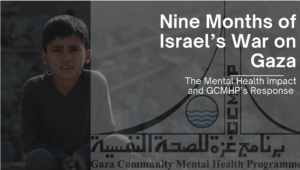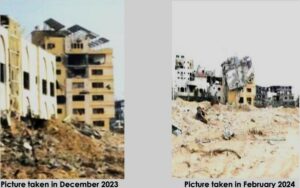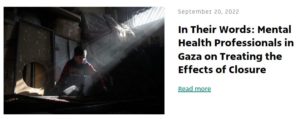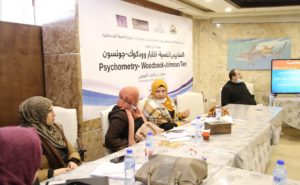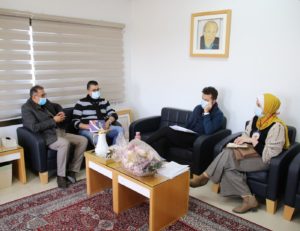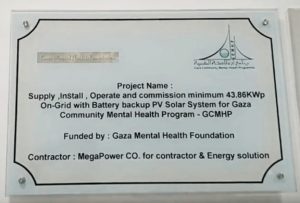GCMHP is a leading Palestinian non-profit organization founded in 1990 and based in the Gaza Strip. It works in the fields of mental health and human rights and aims at delivering high quality mental health services to the Palestinian community of Gaza, through the provision of psychological, clinical and social training and research services. The organization lays a special emphasis on vulnerable groups such as children, women and victims of torture and human rights violations, to who it dedicates special lobbying and advocacy services.
Caring for survivors
New report reveals mental health Impact on Gaza
Links to Aug 3, 2024 recording below
Gaza’s largest independent mental health organization, the Gaza Community Mental Health Programme (GCMHP), is today issuing a report on how the people of the Gaza Strip have been coping with nine months of military aggression, siege, displacement and severe violations of human rights.
“Nine Months of Israel’s War on Gaza: the Mental Health Impacts and the GCMHP’s Response” stresses the urgent need to restore safety and some possibility of hope and recommends that psychological support is made a top priority and an essential part of humanitarian aid to the Gaza Strip.
The report is based on clinical data gathered by mental health professionals who have sustained the GCMHP’s work despite the destruction of two out of its three clinics, the damage to a third, and the losses experienced by its staff.
It draws attention to different levels of trauma from the destruction of homes, the loss of multiple family members, repeated displacements, abuse, and torture in Israeli prisons and the impact of starvation and malnutrition. It describes the devastating psychological impacts on Gaza’s youngest citizens, many of whom are orphaned, many severely wounded and whose whole experience of childhood is so severely compromised.
GCMHP teams have provided Psychological First Aid (PFA) to victims of complex trauma visited in tents and shelters. They report high levels of helplessness and despair, severe psychosomatic symptoms, and detail the impact on Gaza’s children of loss and constant terror and uncertainty. The report uses individual narratives and children’s drawings to bring home both the enormity of suffering and the powerful human bonds that this essential focus on mental health reveals.
In this sea of need, some who develop serious mental disorders are now receiving professional treatment from GCMHP. But without safety in the form of a permanent ceasefire and adequate access to medications, the staff is limited in what it can accomplish.
“People need to feel that they are safe for the society to be reconstructed”, the report emphasizes. It underlines too the society’s need for hope and urges the international community “to undertake supporting people in reconstructing their homes and work to ensure that they have a future.”
The report, which is available here, will be discussed at a webinar on Saturday, August 3, 2024.
Webinar: Discussion Session
Webinar: Q&A Session
Read The Report Here (PDF Reader Required)
Update on the GCMHP During the Current Offensive on Gaza – 15 March 2024
The ongoing siege by unprecedented Israeli airstrikes and land attacks in the Gaza Strip on civilian facilities and lives has caused the forced displacement of hundreds of thousands of residents to other governorates of Al-Wusta, Khan Yunis, and Rafah. The destruction and deterioration of critical infrastructure, shortage of basic humanitarian aid, and loss of lives since October 2023, has diminished the ability of GCMHP to offer mental health services.
Currently GCMHP is operating two rented temporary places in Rafah and Deir Albalah:
-
Rafah: Al Namat Charity Association. Address: Rahah-Nazmi Zourob St., Syamat Area.
-
Deir Albalah: Nawa Association. Address: Torazy St.
Main Challenges:
-
The death and injury of some of the GCMHP’s professional and administrative employees during the various periods of offensive and the challenges of ensuring and maintaining the safety of crews. [List]
-
Demolition and damage to the buildings affiliated with the program and the challenges of preserving what remained of their contents. The GCMHP headquarters and Gaza Community Center in Gaza City and the Khan Younis Community Center have been destroyed while the Dier AlBalah Community Center has been partially damaged.
-
Internal and external communication because of the interruption of electricity, the Internet, and cellular and landline communication services.
-
Challenges related to the lack of medications, supplies, psychological first aid kits, throughout the period of aggression.
-
Continuous displacement of staff and the inability of employees to provide their families’ basic needs of food, drink, clothing, and housing. 95% of employees have been displaced from their areas of residence more than once, with most being displaced more than 3 times during the period of aggression. Some were housed in schools and shelters while others were in simple tents and plastic houses in the streets under harsh and inhumane conditions of winter’s rain and bitterly cold storms.
-
Documentation and data collection: lack of communication infrastructure, buildings and equipment, displacement and living conditions, and the loss of contact with most employees have greatly contributed to the lack of documenting and collecting data about the work from professionals and employees on a regular and organized basis.
-
The privacy of cases, professional standards for places where services are provided, the safety of beneficiaries, and the availability of safe places because of the threat of bombings have had a major impact on the effectiveness and quality of the services provided.
-
The cessation of non-governmental organizations and other service providers from working in the Gaza Strip.
-
Field security impacting the ability to talk to families or individuals in the community with the aim of intervening or providing data and advice.
-
Communities are focused on basic needs such as food, water, housing, and what helps them survive compared to physical and psychological recovery.
-
Headquarters and Gaza Community Center
- Khan Younis Community Center
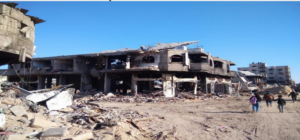
- Dier AlBalah Community Center
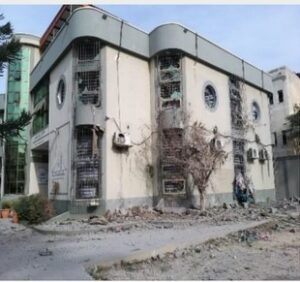
January – March 2024 Activities
This period saw the start of the ground operations in the middle zone and Khan Yunis governorates, with aerial bombardments affecting civilian facilities, families, homes of civilian residents with fire belts in the streets and in all regions. A mass displacement to the areas of Deir al-Balah and the Mawasi Khan Yunis and Rafah. While cellular and landline communication networks and the Internet remained partially available, all electricity generators stopped and electricity was cut off throughout the Gaza Strip.
• The Khan Yunis Community Center has completely ceased operation, while the Deir Al-Balah Center continues to operate partially to continue providing the necessary medicines and therapeutic services to patients from 9 am to 1 pm twice a week.
• Operations reviewed and plans modified to factor in the displacement of most people to Rafah.
• Work and mental health services continue through rented temporary mobile clinics in Rafah to continue providing therapeutic services.
• Psychological first aid and psychological counselling sessions continue to be provided in various displacement shelters and areas.
• Peer support sessions were implemented in the new clinic located at the South Society for Women’s Health.
• Clinical cases are followed up by professionals.
2022
January 26, 2022: GCMHP and Physician for Human Rights (PHR) co-organized a number of joint educational seminars across the Gaza strip under the umbrella of the larger “Unblocking the Future” initiative sponsored by the European Union. Training sessions for mental health workers included topics such as utilization of TIR (Traumatic Incidence Reduction) techniques, and administration of psychometric tests such as Wechsler and Woodcock-Johnson.
January 25, 2022: A delegation from the International Red Cross visited GCMHP and met with its director, Dr. Yasser Abu Jamei and discussed opportunities for future collaborations. The delegation also learned about the scope of services available at GCMHP and how it’s tirelessly serving the community, especially in the fields of training and capacity building.
January 21,2022:
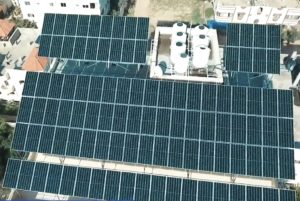
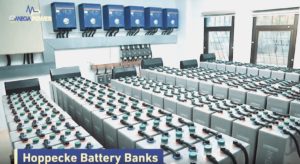 Infrastructure such as electricity to power equipment, computers and lights play a vital role in supporting mental health offerings at GCMHP. Electricity is limited to eight hours per day. The Gaza Mental Health Foundation, through your generous donations, is proud to have contributed to the installation of a new solar panel system.
Infrastructure such as electricity to power equipment, computers and lights play a vital role in supporting mental health offerings at GCMHP. Electricity is limited to eight hours per day. The Gaza Mental Health Foundation, through your generous donations, is proud to have contributed to the installation of a new solar panel system.
“We almost stopped using the generator although the power shortage is still the same (8 hours on, 8 off). We save fuel and use the cost to support our interventions.”
Dr Yasser Abu Jamei
2021
03/26/2021
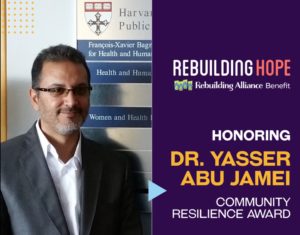 The Gaza Mental Health Foundation congratulates Dr. Yasser Abu Jamei, the Director General of the Gaza Community Mental Health Programme (GCMHP) and a partner organization in the Gaza Strip, for receiving the 2021 Community Resilience Award from Rebuilding Alliance, a US non-profit organization based in California. This international award recognizes the service by Dr. Abu Jamei and the GCMHP staff for their mental health work in the Gaza community.
The Gaza Mental Health Foundation congratulates Dr. Yasser Abu Jamei, the Director General of the Gaza Community Mental Health Programme (GCMHP) and a partner organization in the Gaza Strip, for receiving the 2021 Community Resilience Award from Rebuilding Alliance, a US non-profit organization based in California. This international award recognizes the service by Dr. Abu Jamei and the GCMHP staff for their mental health work in the Gaza community.
“This award is not only for me; it is also for Gaza Community Mental Health Programme and all the Palestinians who dream of freedom and justice and who have been struggling for decades for having a promising future.”
2020
09/01/2020
290 COVID positive cases including two cases in critical conditions and another 20 in moderate to severe conditions” is the main news in Gaza this evening, September the 1st. 290 in a population of two million people is not a big issue one would say. The count started already a week ago with discovering the very first 4 cases in Gaza. Since then each day another 40-50 cases were discovered. However, lets keep in mind that only selective cases were screened. Those who were in contact with positive cases were screened. But the more troublesome fact is that those 290 cases are spread all over the Gaza Strip. The Ministry of Health Marked Gaza city and Northern Gaza red, the remaining areas in the strip yellow and only 2 districts in Rafah green. Yellow means lockdown for 48 hours. Red means lockdown until further notice and green you can move around during the day! More than 1 million people live in an area marked red with instructions not to leave home unless for urgent matters. Piles of sand and concrete blocks are put in the crossings in order to separate not only between cities, but also between neighborhoods.
1 Million people, half of them are children are expected to stay in their crowded homes with only 4 hours of electricity per day until further notice! That was the case until an announcement was made yesterday evening. The announcement that brought some comfort to the people. The Qatari mediator managed to make a (deal) or agreement between Israel and the local authorities to stop the balloons in exchange of easing the blockade. Israel started this morning allowing fuel to reach Gaza Strip’s only power plant, which means returning to 8 hours shifts of electricity. A better condition than 4. Fishermen are allowed back into the sea and construction material can pass through! It was announced that more projects will begin operating in Gaza and more poor families are going to be supported.
With every escalation that touches the lives of people there is a sad story to tell. There are usually plenty of them, but you find one or two striking. Today the fuel started reaching the power plant. It takes about 8 hours for the plant to deliver the maximum power it produces and then the power supply starts to improve. In simple calculations, an improvement is most likely to happen from today evening. It was in the early evening when a family in Nusseirat Refugee Camp, used candlelight in their children’s bedroom. The intention is to have some light and help children sleep. The children slept, but the candles caused a big fire that killed three children from the family. Another catastrophe that we kept hearing almost every year for the last decade or so. Perhaps it was a matter of hours, or even minutes until the power supply is back… but who could bring those children back!
Many are in need for psychological interventions and our patients need their medications and psychotherapy. The MoH will allow us to start visiting our patients and give them the needed medications. Beginning from tomorrow, three mobile teams (clinics) will start visiting our patients and provide treatment as possible. The MoH will issue the permits tomorrow and we will reach out soon. The only medical facilities that are operating under the current lockdown and since one week are emergency operating rooms and the care of COVID patients. Other services are on hold. The MoH and UNRWA are also running mobile clinics to provide medications to their patients. Our training activities continued this week using virtual learning. Our toll-free line is operating as usual. We are doing our best, but the last thing we need is another catastrophe!
All the best
Yasser
8/27/2020
It’s a matter of time. Everyone knew that COVID 19 is going to reach Gaza, but when and how was the question. The local authorities did their best in order to maintain the Gaza Strip, a COVID Free Area. That worked well for 7 months. The decision was based on the realities that kept Gaza almost disconnected from the world. The realities of blockade, movement restrictions and above all, the occupation. Additional movement restrictions on the borders were made. This time by the local authority and aiming at controlling people who come to Gaza and sending them upon arrival to quarantine centers. They would stay there for 2 or 3 weeks until its proven that they are COVID free. If not, they will continue to be there until they recover and test negative.
That was the only and best solution given the realities of Gaza. The reality of the underdeveloped health system paralyzed by the Palestinian division and the continuous pressure caused by the attacks on Gaza, the casualties from the Great March of Return and the lack of staffing. The reality is that 2 million people live in a small geographical area of 365 square kilometers (141 sq mi) with two thirds of the population being refugees. The reality is that the poverty rate among this population is 53% and the unemployment rate is 54%. That more than 95% of water is not potable and electricity is available for 8 hours per day in its best circumstances.
There were other safety measures made by the authorities in order to stop possible spread of the virus. These were similar to measures taken by other places (social distancing) including stopping the education system, closing open markets, not allowing big gatherings including mourning houses and celebrating weddings, closing mosques and applying sanitizing measures wherever it’s possible. Some of those measures caused a sharp increase in poverty and unemployment. The Ministry of Social Development added ten thousand families to it’s beneficiaries in an attempt to respond to the increased poverty. People working from hand to mouth were mostly affected. Those pressures building on historical pressures resulting from traumas and losses related to previous large-scale operations on Gaza strip, the casualties of the great march of return demonstrations and the continuous blockade had intense psychological and social repercussions on the population. In April, GCMHP issued a factsheet in cooperation with PNGO describing the mental health conditions in Gaza Strip in the shade of COVID 19. The Fact Sheet highlighted the need to pay special attention to vulnerable groups including children, elderly people, patients with serious illnesses (cancer and casualties of the GMR) and above all people with economic hardship. Main psychological implications were anxieties, fear of getting infected, feelings of isolation and worries about addressing the needs of children. People in quarantine centers and their families were mostly affected. The fact sheet also highlighted an increase in violence against women and children.
The conditions in the strip guided GCMHP to modify it’s plan for 2020. In agreement with the core donors (Consortium of Donors) GCMHP started a Crisis Response Plan covering the period April-September 2020. The Plan includes scaling up activities related to awareness raising and addressing the community at large keeping in mind the restrictions on carrying public meetings and workshops. The Toll-Free Telephone Counselling Service was also expanded to work 12 hours a day, 7 days a week. Activities to be carried with schools and kindergartens were postponed and replaced with increasing awareness campaigns using social media and other media platforms that targeted parents. Therapeutic interventions were modified in order to ensure social distancing, avoid crowded clinics and ensure continuity of therapy. The Capacity Building activities were carried through online means or (if not possible) rescheduled.
Monday August 24, 2020 carried dramatic news to the population in the Gaza Strip. Earlier that day, a health official from Makassed Hospital – Jerusalem informed the health officials in Gaza that a Gazan lady is present in the hospital and has COVID 19. The lady was there as a companion of her sick daughter. They crossed to Jerusalem Six days earlier. The MoH in Gaza reached her family who lives in Maghazi camp in the middle area of Gaza Strip and tested her family members. Four among them tested positive. One among the four is a supermarket owner. Another one works as a school keeper. The lady, just before leaving Gaza, attended a wedding!!! Few weeks earlier, the local authorities took several measures easing the restrictions. This was based on the fact that Gaza is COVID free. Mosques were opened. Gatherings were allowed and the students started going to schools in the first week of August. The news was a big shock to everyone. An arbitrary sample from Shifa hospital, the biggest hospital in Gaza was made to test some patients for COVID 19. Two patients tested positive. They are not related at all to the family from Maghazi camp. As of now, the afternoon of Thursday the 27th, 2 people have passed away due to COVID and 40 cases tested positive. These are all from the community and not from the quarantine centers. Another 37 cases were discovered in the quarantine centers among people returning from abroad. Patients come from different locations and figures are rising. The MoH said that it’s most likely that COVID 19 was in the community from early August.
Immediate lockdown was imposed on Gaza Strip by the local authority since Monday evening. The lockdown was initially for 48 hours, then it was extended for another 72 hours. Currently people can move by walking and only in their districts. People were not prepared for the restrictions. Currently bakeries and some shops and groceries are open. The authorities say that there should not be a problem with the availability of food. But let us not forget how the people’s living conditions are. The poverty, problems with water, electricity and even access to health. The developments were surprising to the overcrowded community that is still in shock. People are following the news minute to minute. More fear and anxiety and more worries about how to survive. People working from hand to mouth are at stake.
Tuesday morning, we contacted the MoH asking if we could open our three community centers. The request was not accepted. The MoH closed all primary health care services, postponed all surgical operations and is open only for emergency procedures. They are aiming at identifying foci of the COVID 19 and control the spread. However, we kept operating our toll-free line and intensified our media campaigns. Among people who call are our patients. They are asking how and when they could get their medication. Our plan is to run three mobile clinics to reach our patients and give them the medications and connect them with their therapists through mobile phones. Hopefully the MoH would allow this to start early next week.
One could imagine that these are enough troubles for the people in Gaza. Unfortunately, other stressful developments took place during the last couple of weeks. Fire Balloons are resumed towards Israel. Palestinians in Gaza strip live in despair and demand an end of the blockade. Balloons became means to add pressure on Israel to ease the restrictions. However, Israel responded with airstrikes that happen usually during the night terrifying the population and stopping fuel from entering Gaza. For the last week or so, we have electricity for almost 4 hours a day as the only power plant shut down. Would there be another escalation on Gaza strip during the coming few days or weeks? Would the future bring trauma and losses to people in frustration and despair!
Yasser Abu Jamei MD
Director General
Gaza Community Mental Health Programme
August 27, 2020



